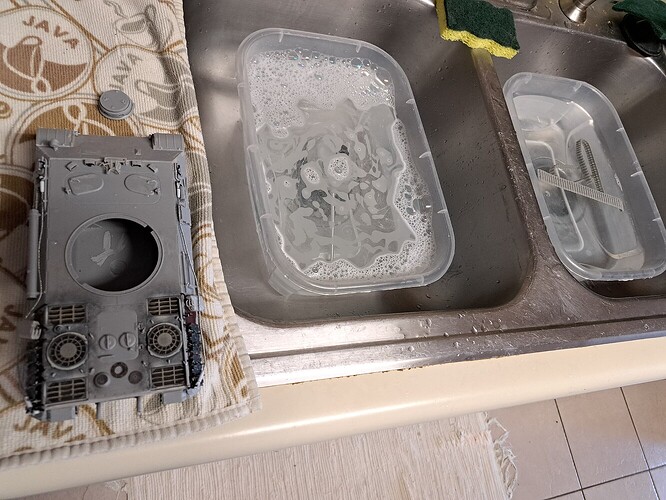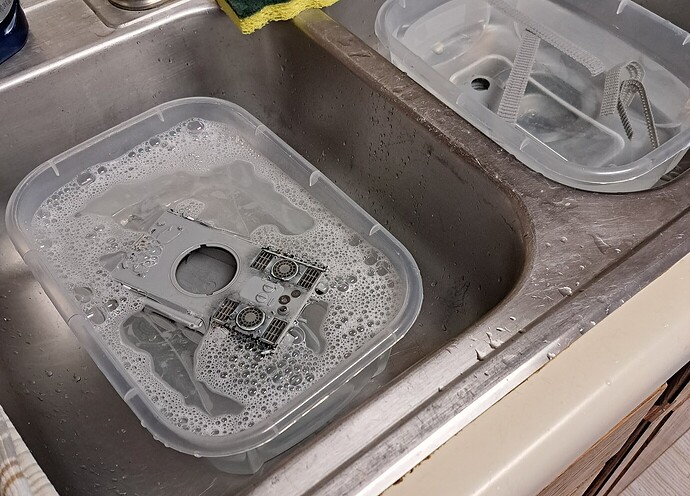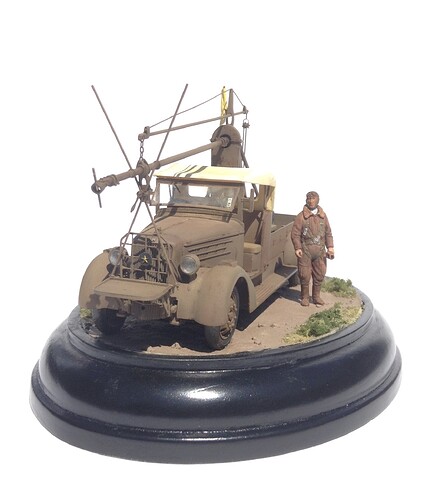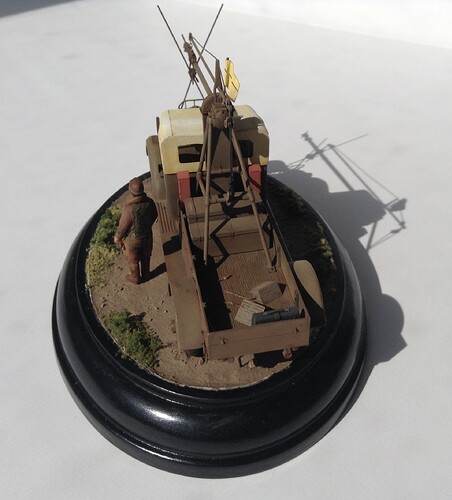That is the question. Prime without washing? What think thee?
Don’t ask me … I break every conventional rule in the book … never washed a kit once …![]() .
.
Ditto here. But I do not use water based paints for base coat or primers.
I only ever wash kit parts if my grubby hands get finger prints on them. I usually wear gloves but sometimes can’t be bothered
Same here - never washed a kit. I don’t prime either except for pioneer tools and figures.
Depends on the kit and paint. Older US and Eastern European kits I will wash most of the time but not on newer kits unless if can see/feel something on the plastic. I don’t usually primer when using Tamiya paints but will every time with Vallejo and similar types.
HTH
Why not wash ? A drop or two of Dawn dishwashing detergent and a few minutes work to avoid the potential disaster of paint coming off .
The potential is very real with Vallejo acrylic paint - ask me how I know.
Here’s a tip I got straight from Steve Zaloga. If you know the name, you’ll know why I took his advice. If you have a clean model, you don’t need to prime. After you’ve spent umpteen hours detailing the snots out of your kit, you want to cover those details with as few layers of paint as possible. So, when you finish your build, wash your kit. To wash it without disturbing any of the detail, take it to the kitchen sink and get a bottle of Windex with ammonia. Spray the model liberally all over with Windex, drenching it. This will clean and dissolve any mold release agents, skin oil, sanding dust, and crud left on the model. Then gently rinse the model under clear water with the sink sprayer. Place the model under an overturned Tupperware container with a pencil under one edge to let the model dry dust free.
Then pick up your model with a gloved hand and go ahead with your base coat.
This has been working flawlessly for me for 25 years.
Thank you all. The deed is done. However… one more request for answers to a rookie’s question: I intend to cover the primer (redbrown) with clear flat finish and follow that with the finish color (white). My thinking is that I should be able to do a damp (wet?) scrub on the white so that the untouched red primer shows thru the wear. Am I barking up the right tree?
Did you consider using chipping fluid or something similar?
Yes, wash for all the reasons Matt mentioned. It’s amazing how much crap can accumulate in recesses. Some of that hidden dust and debris can suddenly move during airbrushing on to a freshly painted surface and create a dirt filled paint job. Strip it and redo or flick the dirt out with a scapel blade and touching up…both types of repairs suck.
Plus (wink)
According to the Book of Armaments of Monty Python… a day at the tank wash…is a day well spent!
Some may sprinkle & spray…and that gets the job done…however being a Baptist, I favor full immersion…
Going under the water aka (baptism) is the only way I’m doing this!..wink!
I like to use a pair of small plastic storage containers…that way if a small part comes loose its easier to retrieve.
Couple of panzers getting a much needed bath.
That was almost exactly my response a few years ago when the same questions was posed. More layers of paint increase the likelihood of covering detail. Or even a paint mishap. Same reason I don’t preshade. I find the effect “artsy” and unrealistic, and it’s just more paint, more cleaning, more time spent on something that (for me) doesn’t add to the realism one bit.
I washed a kit once. It was the old IT-28 Soviet Bridgelayer boxed from ICM. There were actual grease (mold release) puddled and smeared over the large pieces in the kit. Similar to 1:1 machinery purchased from overseas.
I think the water-based acrylic (white paint) will make way when I scrub/swab/or however and the clear lacquer will protect the acrylic primer.
Right now I’m going to gray prime all the bits and pieces before they go on at this level of construction. The larger pieces: batteries, fire extinguishers, radio and dashboard will be completely finished before installation.
There’s so much more to do… 90 years old is probably not the right time to be doing this… Grins…
Thanks again for advice, etc…
I bet you do just fine! Post pictures if you want.
What we like in a model is subjective of course - to each their own.
Regarding obscuring details with many layers of finish - yes the potential exists . However , to get certain effects it is necessary.
I offer as an example a 1/48 scale Japanese Hucks type starter truck I built some years ago . It was the subject of my very first blog ever on the old Aeroscale site . The basis was Hasegawa’s Isuzu truck but highly modified and largely scratch built.
Primed , pre shaded , color modulation , filters , flat coated . LOTS of layers here folks . No loss of details that I can discern.
Agreed that with each step the chance of screwing something up exists but the end result is worth the risk to my way of thinking. In my experience there are no shortcuts to achieve this kind of effect. It’s about growth as a modeler.
Edit - yes , I washed it before painting - LOL
Not continue flogging a dead horse but in addition to my previous post I offer my current project .
Please believe me that I am not doing this to toot my own horn but in the spirit of quantifying the paint layers .
This model was primed with Tamiya fine grey surface primer from a rattle can .
Next airbrushed two coats of Tamiya acrylic Red Brown thinned. 50/50 with Tamiya yellow cap lacquer thinner.
Next shot with one coat Testor’s Dullcoat thinned 50/50 .
Hairspray then applied in two light coats straight from the can .
Three different shades of yellow custom mixed from Tamiya’s acrylic flat yellow.
That’s eight layers and no loss of details that I can see .
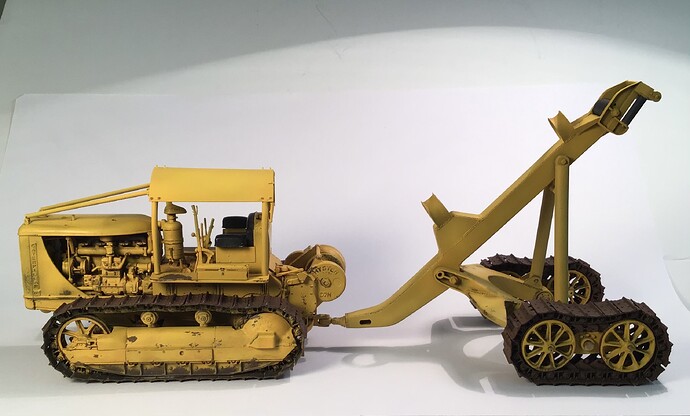
The Caterpillar name , Hyster name , tiny bolt details all sharp .
YMMV of course.
I’ve made it a regular habit to wash Styrene parts, at least after handling before paint. In the case of Resin parts, I wash them before and after handling them. ![]()
My latest trick is to place smaller subassemblies into a glass jar with either soapy water or IPA (Isopropyl Alcohol). I close the lid a hold it on a ‘Vortex Mixer.’ Shake, rattle and roll! … and you can see the residue which collects in the liquid.
—mike 🪇
I have found that washing the kit before building using a denatured alcohol bath and a soft brush then drying by air and towel blotting works well, with no primer. Then I’m careful to wash my hands before each build session ( no gloves ) and it goes well. Your plan for primer, then clear finish then white sounds alot like the hairspray technique which works very well.
It depends on the modeler. There was a helicopter model shown here about a year ago in which the modelr managed to clog up the screens on the nose with presumably one coat of paint. Same for a Bradley build.
I myslef am not the world’s greatest modeler. I prefer not to take the chance. ![]()

